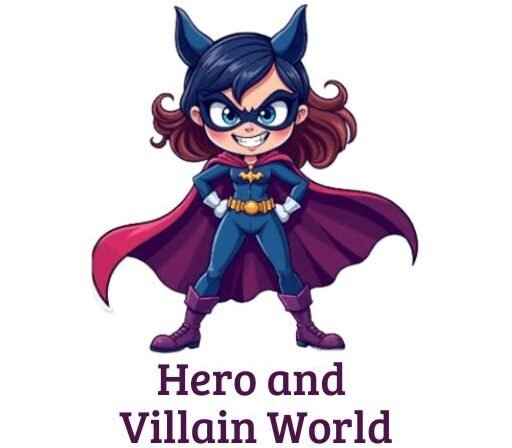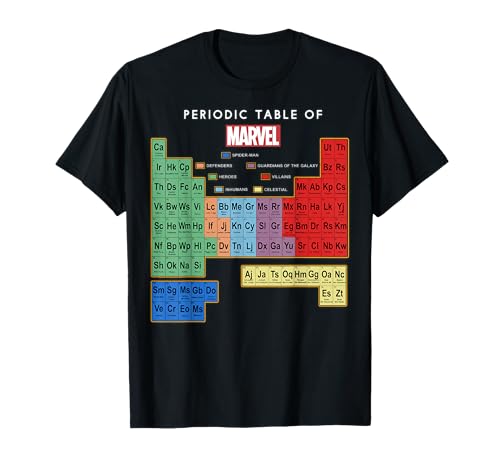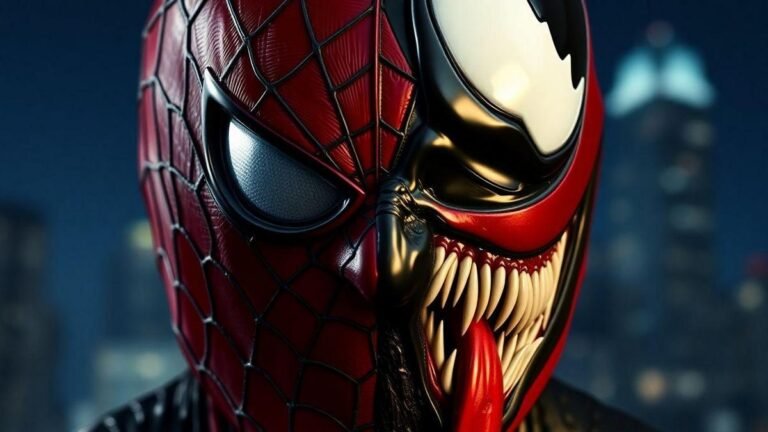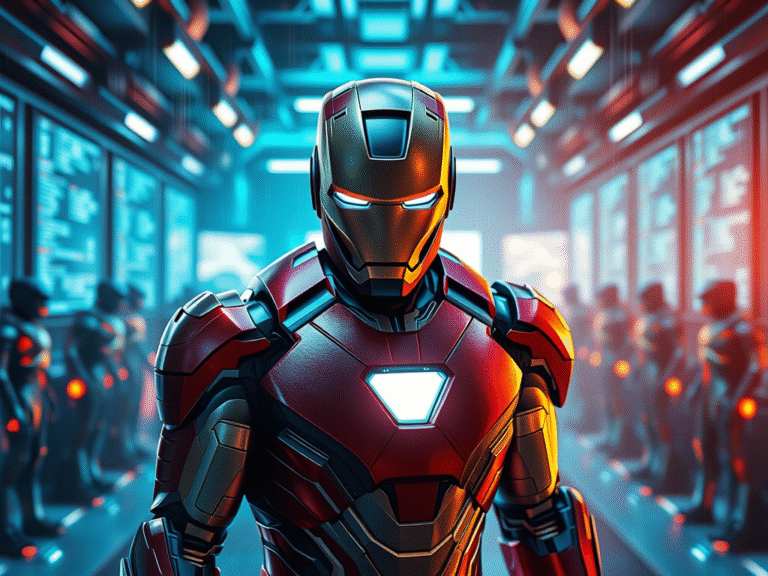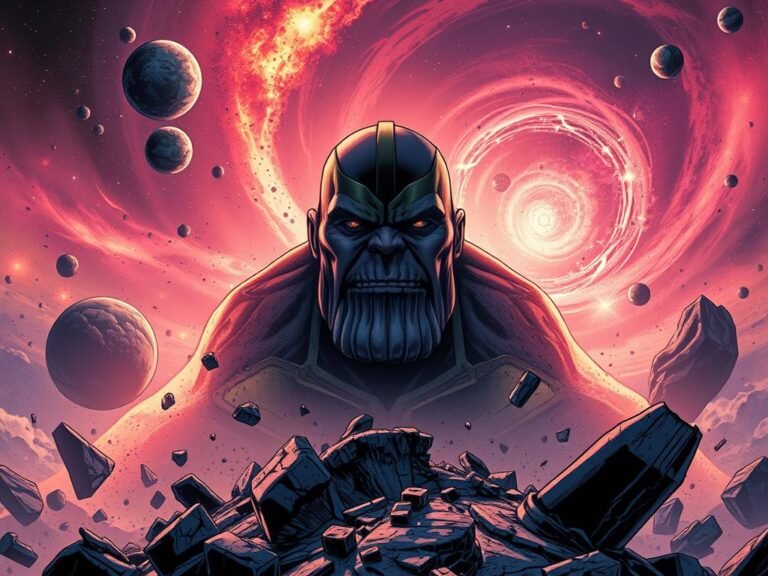Batman Adaptations Decades Compared

Ever thought about how Batman changed from a black-and-white hero to today’s complex icon? His journey through time shows how culture and movies have evolved together.
Every decade has given Batman a new look, showing more than just superhero stories. From the 1960s’ campy versions to today’s gritty films, he keeps changing.
Exploring Batman’s movie history, you’ll see how different people and times have shaped him. Each era brought its own twist, reflecting both comic book tales and big social changes.
This deep dive into Batman’s movie life will show his amazing growth. From a local hero to a global icon, his visual transformation is truly remarkable.
The Origins of Batman on Screen: 1940s Serials
The 1940s were a key time for Batman on screen. The first Batman movie came out during World War II. This was a big moment for the superhero’s role in movies.
The 1943 serial was a game-changer. It introduced a world of superhero adventures. Lewis Wilson was the first to play Batman, making the character come alive in a new way.
Lewis Wilson’s Pioneering Performance
Wilson’s Batman was groundbreaking. He showed the character as a symbol of justice and courage during wartime. The serial’s black-and-white look, gritty city scenes, and patriotic themes captivated viewers.
- Dramatic black-and-white cinematography
- Gritty urban landscapes
- Patriotic undertones typical of the era
Wartime Influence on Early Batman
The World War II era had a big impact on Batman’s early movies. The stories included themes of patriotism and national pride. Each episode showed America’s strength and determination.
Introduction of Core Batman Elements
This serial introduced key Batman elements. The Batcave and Alfred, Batman’s trusted butler, were first seen on screen. These elements have been part of Batman stories ever since.
“The 1940s Batman serial was more than entertainment – it was a cultural milestone” – Film Historians
The Campy Revolution: 1960s Batman Era
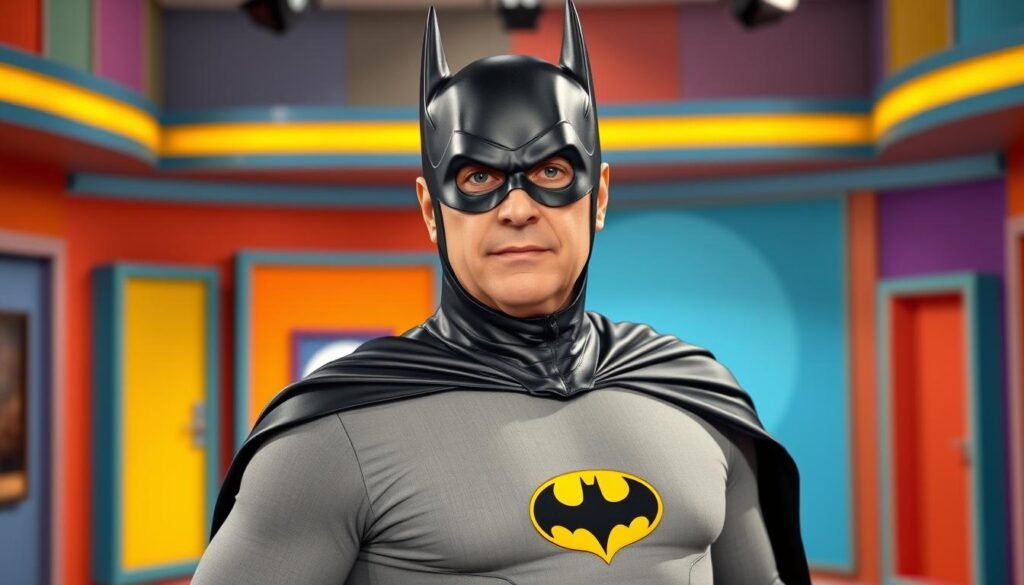
In the swinging 1960s, Batman changed in a big way. The iconic TV series starring Adam West made him a comedic hero. This change made Batman a big hit in pop culture.
West’s Batman was a TV sensation. He brought the character to life with campy humor and bright colors. The show was known for:
- Exaggerated fight scenes with comic book-style sound effects
- Outlandish villains with elaborate costumes
- Witty dialogue and tongue-in-cheek humor
- Bright, saturated color palette
The series made Batman a playful, almost satirical character. Viewers loved the show’s silly moments. West’s deadpan delivery of ridiculous lines became unforgettable. Phrases like “Holy [something], Batman!” became part of our culture.
The 1960s Batman era also led to a lot of merchandising. Toys, lunch boxes, and clothes with West’s Batman were everywhere. This made Batman a staple in American pop culture. Even though some comic fans didn’t like it, it brought Batman to more people and paved the way for new versions.
“Some days, you just can’t get rid of a bomb!” – Adam West’s Batman
Dark Knight Renaissance: 1980s Burton Vision
The late 1980s was a key time for Batman, bringing a new cinematic vision that changed superhero stories forever. Tim Burton’s work gave new life to Batman, causing big changes that would be seen in future movies.
Michael Keaton’s Controversial Casting
When Michael Keaton was cast as Batman, fans were shocked. Known for comedy, Keaton was an unexpected choice. His casting was a bold move that surprised and proved critics wrong.
- Initially met with fan skepticism
- Transformed public perception of Batman
- Demonstrated depth beyond traditional superhero archetypes
Gothic Aesthetic Impact
Burton’s unique style turned Batman into a brooding, complex hero. He used dark buildings, detailed costumes, and a moody color scheme. This changed the look of superhero movies, setting a new standard.
Box Office Breaking Records
The 1989 Batman movie made over $411 million worldwide. This huge success showed that audiences wanted deeper, more complex characters. It marked a big change in superhero movies.
Batman Adaptations Decades Compared: 1990s Style Shift
The 1990s were a big change for Batman movies. They brought a mix of styles that shook up the usual superhero stories. This decade was all about trying new things with the Dark Knight.
Tim Burton started the decade with Batman Returns in 1992. He kept his dark and quirky style from before. This made Batman movies even more unique and different from before.
- Burton’s Batman: Macabre and psychologically complex
- Joel Schumacher’s Era: Vibrant and campy aesthetic
- Shifting studio perspectives on superhero storytelling
Then, Batman Forever came out in the mid-1990s, directed by Joel Schumacher. It brought a bright and fun twist to Batman. This was a big change from Burton’s darker movies.
| Film | Director | Batman Actor | Visual Style |
|---|---|---|---|
| Batman Returns | Tim Burton | Michael Keaton | Dark, Gothic |
| Batman Forever | Joel Schumacher | Val Kilmer | Neon, Vibrant |
| Batman & Robin | Joel Schumacher | George Clooney | Campy, Exaggerated |
By the end of the decade, Batman & Robin showed the biggest change. It went all out with a bold style. This led to a fresh start for the franchise in the years that followed. These changes show how flexible and exciting Batman movies can be.
The Schumacher Era: Neon and Nipples
The late 1990s brought a big change to Batman movies. Joel Schumacher’s direction made the franchise bright and campy. This move was both memorable and sparked debate.
From Kilmer to Clooney: A Colorful Transition
Val Kilmer started it all in Batman Forever (1995). Then, George Clooney took over. This change wasn’t just about new actors. It was a total makeover of the superhero look.
- Brighter color palette replacing darker tones
- Increased focus on visual spectacle
- More comedic approach to superhero storytelling
Box Office versus Critical Reception
Even though critics were tough, Schumacher’s films did well at the box office. Batman & Robin (1997) showed how fans and critics can differ in superhero movies.
Marketing and Pop Culture Impact
These movies started a trend in merchandising. They turned Batman into a big brand. Action figures and themed products made Batman a household name.
“Bat-nipples and neon lights became an unexpected cultural touchstone”
Despite the backlash, Schumacher’s films changed superhero movies forever. They showed that even the most debated films can leave a mark on cinema.
Nolan’s Realistic Revolution: 2000s Trilogy
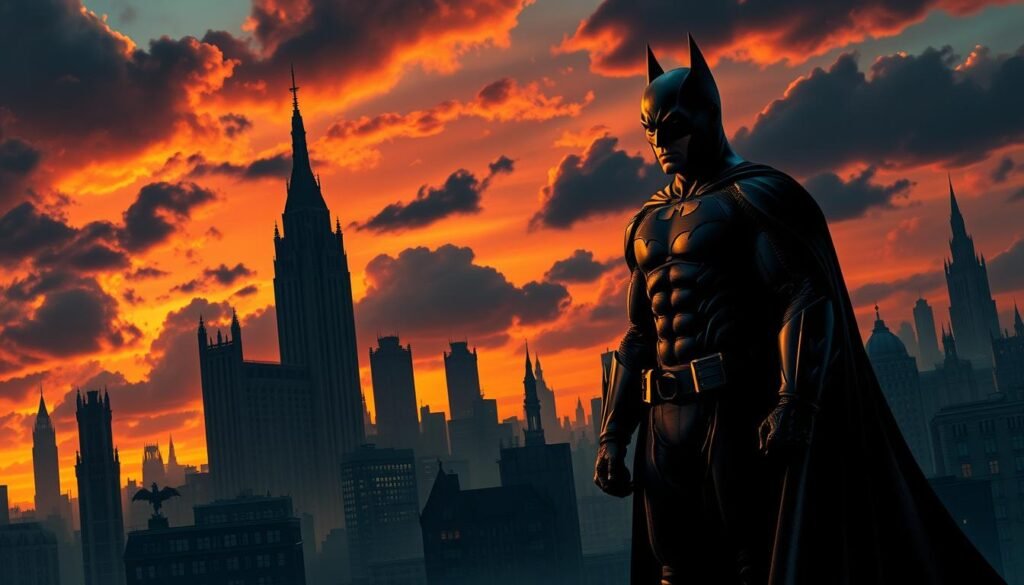
Christopher Nolan changed superhero movies with his Batman trilogy. He made Batman a complex study of the mind. Christian Bale’s acting added depth to Bruce Wayne, making Batman relatable to fans everywhere.
The trilogy brought new ideas to superhero stories:
- Gritty, realistic approach to superhero narratives
- Psychological exploration of heroism and moral complexity
- Cinematic technique that elevated comic book adaptations
Nolan’s vision made Batman feel real by setting him in a gritty city. The films tackled big themes like justice, fear, and change. They went beyond what you’d expect from action movies.
| Film | Release Year | Box Office |
|---|---|---|
| Batman Begins | 2005 | $373 million |
| The Dark Knight | 2008 | $1.005 billion |
| The Dark Knight Rises | 2012 | $1.085 billion |
Nolan’s work redefined Batman for a new audience. He showed how to make superheroes smart and visually stunning. His work still inspires many today.
“I’m whatever Gotham needs me to be.” – Batman
Modern Interpretations: 2010s Shared Universe
The 2010s were a big change for Batman movies. The DC Extended Universe (DCEU) brought a new way to tell superhero stories. Batman became a key part of a bigger story world.
Ben Affleck’s Batman was a turning point. He played an older, more worn-out Batman. The idea of the multiverse let us see Batman in new ways. Learn more about the multiverse and how it changed Batman.
Ben Affleck’s Older Batman
Affleck’s Batman was different. He was an older, experienced crimefighter. His Batman was known for:
- A mature and world-weary look
- Physical strength from years of fighting
- Deep emotional depth
Justice League Integration
Batman’s role changed with the shared universe. He became a team player. Affleck’s Batman was a key player in the superhero team.
Cross-Movie Storytelling
Batman’s role grew beyond single movies. His stories connected, making a bigger, more complex universe. This showed Batman’s ability to adapt and stay popular.
The Batman’s Neo-Noir Approach: 2020s
Batman modern interpretations hit a new high with Matt Reeves’ film in 2022. Robert Pattinson’s take on the Dark Knight brought a gritty, detective-focused twist. This changed how we see Batman for a new era.
The movie went for a dark, neo-noir look, ditching old superhero norms. Pattinson’s Batman is a deep-thinking detective, exploring Gotham’s dark side with a new level of depth.
- Emphasized detective skills over physical combat
- Explored Batman’s early career struggles
- Created a more realistic urban landscape
- Integrated complex psychological character development
Reeves made a visual narrative that stood out from other Batman films. The dark colors and detailed story show a Batman who’s vulnerable and fighting personal battles. He’s also taking on big corruption issues.
| Element | Traditional Approach | 2022 Neo-Noir Approach |
|---|---|---|
| Character Focus | Action-driven superhero | Psychological detective |
| Visual Style | Bright, heroic | Dark, shadowy, atmospheric |
| Narrative Depth | Surface-level conflict | Complex social commentary |
This new take on Batman shows how the character has grown in movies. Pattinson’s acting shows a more serious side of superhero stories. It proves that Batman’s story is always evolving and getting more interesting.
Animation Evolution Across Decades
Batman’s animated journey is a thrilling look at how the character has evolved over time. From early cartoons to complex stories, animated shows have made the Dark Knight relatable for each new generation.
The Batman: The Animated Series from the 1990s changed superhero animation forever. Its dark style and deep character stories raised the bar for all future Batman shows.
- 1940s: Simplistic serial animations
- 1960s: Campy cartoon representations
- 1990s: Mature storytelling with BTAS
- 2000s: Expanded DC animated universe
- 2010s: Direct-to-video narrative films
Each time period brought its own take on Batman, turning him from a simple character to a complex hero. The animated world gave creators the chance to dive deep into Batman’s world.
| Decade | Animation Style | Key Characteristics |
|---|---|---|
| 1990s | Dark Deco | Mature storytelling, complex villains |
| 2000s | Anime-influenced | Expanded universe, interconnected narratives |
| 2010s | Graphic novel adaptations | Direct comic book translations |
These animated stories still draw in fans, showing that Batman’s appeal goes beyond live-action.
Conclusion
Batman’s journey through pop culture is more than just a superhero story. It shows a character who changes with society, reflecting its shifts. From Adam West’s campy 1960s to Christopher Nolan’s Dark Knight, each version captures a moment in time.
Exploring Batman’s movies shows how adaptable he is. His impact goes beyond comics, touching fans in every era. Directors like Tim Burton and Matt Reeves have made the Dark Knight their own, showing Batman’s power as a symbol.
Looking at Batman means seeing how stories and looks have changed over time. Each new generation sees Bruce Wayne and his heroism in their own way. This keeps Batman fresh and exciting for all.
Thinking about Batman’s long history, we wonder what the future holds. The Dark Knight’s ability to change keeps him a symbol of hope for all. He will always be ready to defend Gotham and inspire the world.
FAQ
Q: How did Batman’s screen adaptations change from the 1940s to today?
A: Batman’s movies have changed a lot since the 1940s. They started as campy serials and now are deep, complex stories. Each decade brought a new take, showing how society changed. Batman keeps his core values but changes with the times.
Q: Who was the first actor to portray Batman on screen?
A: Lewis Wilson was the first Batman on screen in the 1940s. He introduced the Batcave and key Batman elements. His role set the stage for future Batmen.
Q: How did the 1960s Batman differ from other adaptations?
A: Adam West’s 1960s Batman was very different. It was campy and fun, unlike other Batmen. This version became a hit, bringing Batman to the mainstream with humor.
Q: What made Tim Burton’s Batman adaptation significant?
A: Tim Burton’s 1980s Batman was groundbreaking. It had a dark, gothic look and a serious tone. Michael Keaton’s casting and the film’s success marked a big change, moving away from the 1960s style.
Q: How did Christopher Nolan change Batman’s cinematic representation?
A: Nolan’s Dark Knight trilogy made Batman more realistic and deep. Christian Bale’s Bruce Wayne explored his mind and moral struggles. This set a new standard for comic book movies.
Q: What makes the latest Batman adaptation unique?
A: Matt Reeves’ The Batman (2022) is a neo-noir take. It focuses on Batman’s detective work and inner battles. Robert Pattinson’s performance brings back Batman’s noir roots, making it stand out while staying true to the character.
Q: How have animated Batman adaptations contributed to the character’s legacy?
A: Animated Batmen have explored new stories and styles. They’ve adapted complex comic tales and influenced live-action films. Animation has reached different audiences, making Batman more appealing to everyone.
Q: Why has Batman remained such an enduring cultural icon?
A: Batman’s lasting appeal comes from his ability to evolve while keeping core values. Each version reflects its time, making him relevant and engaging for all ages. His human side and complex storylines make him relatable and adaptable.
